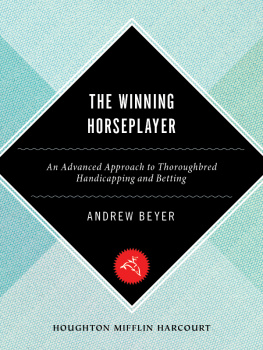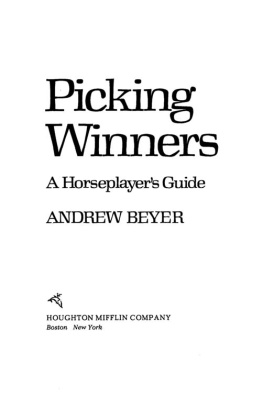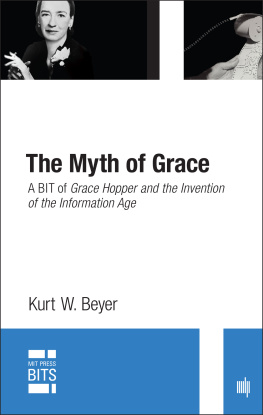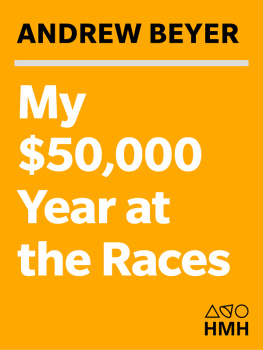Preface copyright 2007 by Andrew Beyer
Copyright 1993 by Andrew Beyer
All rights reserved
For information about permission to reproduce selections from this book, write to Permissions, Houghton Mifflin Company, 215 Park Avenue South, New York, New York 10003.
Visit our Web site: www.houghtonmifflinbooks.com.
The Library of Congress has cataloged the print edition as follows:
Beyer, Andrew.
Beyer on speed : new strategies for racetrack betting / Andrew Beyer.
p. cm.
Originally published: 1993. With new pref.
Includes bibliographical references.
ISBN-13: 978-0-618-87172-8
ISBN-10: 0-618-87172-1
1. Horse racingBetting. 2. Horse racingBetting. I. Title.
SF331.B445 2007
798.401dc22 2006100900
eISBN: 978-0-544-05353-3
v2.0812
TO SUSAN
Preface
Horseplayers often express nostalgia for what they remember as the good old days, when American racetracks were filled with unsophisticated, ill-informed customers and studious handicappers had an edge that enabled them to make consistent profits. I felt such sentiments when Beyer on Speed was first published in 1993.
My impetus for writing the book had been the inclusion of Beyer Speed Figures in the Daily Racing Form's past performances. In my previous books I had painstakingly explained the methodology that would enable handicappers to calculate their own numbers. The process was sufficiently difficult and time-consuming that only the most serious bettors were armed with speed figures. But after those figures started appearing in print, every reader of the Daily Racing Form had access to the same valuable tool. Speed handicappers had lost a crucial advantage. With that edge gone, how could we now beat the game? I attempted to answer that question in Beyer on Speed, but I knew that playing the horses would be tougher than ever and yearned for the good old days.
I could not have imagined that horse racing was just about to enter a golden era. Horseplayers today have more betting opportunities than their counterparts in the past could ever have conceived. And contemporary players have an arsenal of handicapping tools that would be the envy of bettors in any other era.
The most profound change in American racing has been the advent of full-card simulcasting and online betting, enabling handicappers to follow tracks from coast to coast and bet dozens of races a day. In Beyer on Speed I chronicle a week I spent in Las Vegas, where I was mesmerized by the chance to watch and wager on ninety races a day from a casino's race book. At the time it was a novelty to indulge in so much action. But since then full-card simulcasting has become a fixture at almost every American track; bettors typically spend their day in front of a bank of television monitors instead of looking at live animals.
The benefit of simulcasting has been to give horseplayers many more options; they can choose where they want to concentrate their attention instead of being locked into nine races a day at their home track. Some of the worst periods of my gambling life occurred in the pre-simulcasting era, when I was stuck at a track where the racing was unproductive. In 1994 I rented an apartment in Saratoga for a season that was marred with rain and filled with dismal four- and five-horse fields that offered little promise. Because I had no alternatives I was betting anyway, and I suffered through a financially disastrous season. If simulcasting had been available then, I could have shunned Saratoga and turned my attention elsewhere. Now players can seek out the most promising opportunities. In Beyer on Speed, as in my earlier books, I stress the importance of identifying track biases and exploiting them. Some of the biggest scores of my gambling life have come from spotting horses who ran poorly because they were compromised by a bias (for example, a tendency to favor speed horses on the rail) and then betting them in their subsequent starts. In the age of simulcasting, handicappers don't have to wait for a bias to appear at their home track; they can study result charts online and seek out tracks where a bias might exist.
In this book, too, I maintain that horseplayers have a better chance of beating the game by making occasional big scores in exotic bets instead of trying to grind out slow, steady profits. Opportunities for those big scores used to be limited. Now they abound, as simulcast bettors get to play pick-six carryover jackpots in California, New York, Kentucky, and other locations.
The availability of so much action at so many tracks demands discipline from horseplayers. Too many bettors try to play dozens of races a day on the basis of a quickie study of the Daily Racing Form. They are doomed to fail without the knowledge that gives them an edge in the parimutuel competition.
But horseplayers willing to study can obtain the necessary edge. Along with the simulcasting revolution there has been another profound change in the racing game: an information revolution, made possible by computer technology and the Internet. For most of my life as a horseplayer, obtaining information was a large part of the handicapping battle. Much of Beyer on Speed is devoted to the proposition that a horse's figures must be viewed in the context of the way he ran his race: whether he lost ground on the turn; whether he encountered traffic or other trouble during the race; whether he was affected by a track bias. To make the most of these judgments, a handicapper has to watch films of racesand they have not always been accessible. In the mid-1990s, only a few tracks had replay centers that enabled handicappers to summon films of past races. A limited number of them sponsored televised replay shows on a local channel. Many did not make available the vital head-on shots of their races.
When horseraces first appeared on the Internet, the quality of the video was laughably bad, but by 2006 improvements in software and the speed of broadband connections made it possible to see races clearly on a computer screen. Horseplayers could wager and watch live races at a variety of Web sites. They could have access to an extensive library of past races at sites such as Youbet.com and RaceReplays.com. Serious horseplayers who want to assess how a horse ran a recent race no longer have to depend on the often sketchy information in the published past performances. Now a handicapper can watch almost any past race with the click of a mouse.
Handicapping has been revolutionized, too, by the Daily Racing Form's software known as Formulator. It enables the user to download the past performances for a day's card to his computer screen and then click on various segments of the past performances to obtain a wealth of important data. Click on the name of a trainer and find the record of every horse he has saddled in the past five years. Specify different criteria and find the trainer's success rate under those conditionsfor example, with horses laid off for six months or more and dropping in class. Click on the date of a horse's last race and see the records of all his rivals in that field.
Formulator streamlines the analysis of many handicapping factors emphasized in this book. It is extremely important to judge a horse's prior performances in the context of the pace of the races. A horse who earns a moderate speed figure after a hard duel for the lead may be much better than the number suggests. But what constitutes a hard duel? With Formulator, a handicapper can look at the fractional times of other races on the card to judge if the pace of a race was relatively fast or relatively slow. He can look at the past performances of the other horses involved in the duel to see if they are fast, habitual front-runners. Obtaining such information used to require a library of back issues of the
Next page











